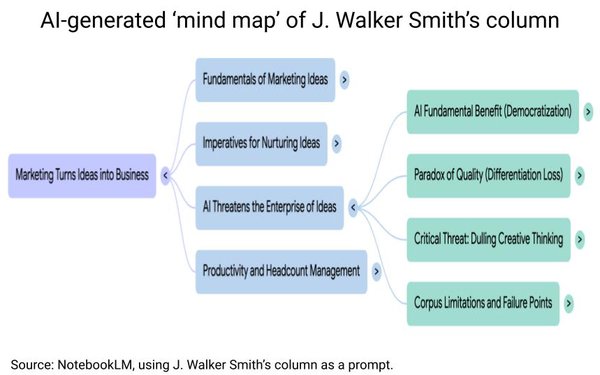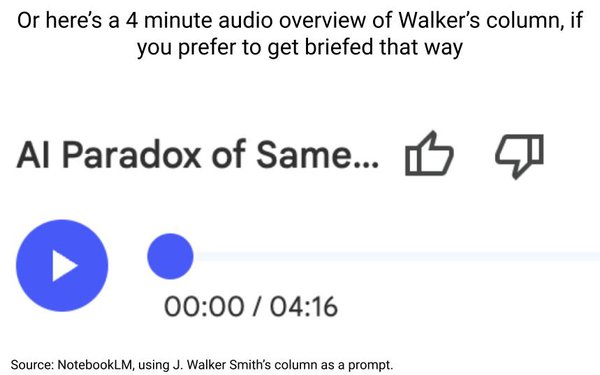
From all my years in research and
consulting, I think I’ve learned a thing or two about marketing worth sharing. Enduring fundamentals, mostly—yet often overlooked. So, over the course of my biweekly column this year, I
want to share some snippets for your consideration. I hope they’re helpful.
This week’s thought: Marketing turns ideas into business.
Ideas are
the heart and soul of marketing. It’s all about intangibles -- lightbulb moments of inventive strategic inspiration. It’s a lot of brain work, and thus marketing is easily mocked. We know
the tropes—the shadowy huddle behind one-way mirrors, sticky notes papering walls, quirky creatives, Madison Avenue extravaganzas and more. Yet, this brain work is hard work, which dead-ends
more often than it takes off. When marketing clicks, though, it is a commercial alchemy unlike any other, turning ideas, the most immaterial of things, into business, perhaps the most material thing
of all.
advertisement
advertisement
The imperative that follows is easy to see but hard to stick to: Intangibles come first. Ideas are essential but ideas are a sensitive crop. Try too hard or bear down too
much and ideas dry up. While too much indulgence and excess will produce inbred ideas and leaden results.
Companies tend to swing between high-flying periods of effortless success
that often smother good new ideas and demanding periods of weakening performance that choke off investment in ideas and innovation. Sustaining the right balance of support and pressure takes good
leadership and patient oversight, which, understandably, is often hard to do. But without it, it is difficult for marketing to stay true to its purpose for turning ideas into business.
When it comes to ideas, marketing is facing its biggest challenge yet. AI threatens the enterprise of ideas. Mind you, these perils are not intractable problems. Marketers can address them,
but first marketers must rouse themselves from the spell of hyperbole that always goes hand-in-hand with big technological advances.
The fundamental benefit of gen AI is that it
makes make extant knowledge about virtually anything available in seconds to anyone with a good prompt. What this means for marketing is the democratization of the best ideas. No longer will costs or
staff or infrastructure provide market-leading companies with an entrenched monopoly of insights and information about the secrets to success. Every company will have the ability to learn what works
best and then put it into action. The overall quality of marketing will rise but at the expense of differentiation.
This paradox of quality has been playing out even before the
explosion of gen AI in November 2022 with the introduction of ChatGPT. Many observers have commented on the sea of sameness in which brands operate these days. In survey after survey, the vast
majority of consumers report that they find it hard to tell the difference between brands. Not because brands are getting worse. Rather, because brands are getting better.
Over the
course of many decades, brands have experimented with all kinds of innovations, out of which the best solutions have been found. All brands copy the best. Every brand moves in the direction of a
breakthrough idea. No brand concedes advantage to competition. So, brands are better than ever yet more similar as well.
AI will make it harder to do something unique. The old
secrets are secrets no longer, and new advances will mainstream more quickly.
Of course, such impact assumes that AI delivers knowledge in an accurate and helpful manner. The
problems of AI hallucination, social bias, cultural-centricity, over-compliance and conformity are well-known. But the critical threat to ideas is one of dulling the edge of sharp, creative
thinking.
People use gen AI for summaries so that they don’t have to read and interpret the material themselves. In effect, they rely on gen AI in the way that senior
executives have historically relied on junior staff. Gen AI is essentially a junior analyst pulling everything together, presenting options and making recommendations. Senior executives have typically
been junior staff themselves, which is part of their background and experience that (hopefully) enables them to be sophisticated consumers of staff reports. But gen AI short-circuits this process.
Gen AI makes a senior executive out of everyone, if you will, and presents summary information in a way that presumes the user to be a sophisticated reader. Which, of course, is simply
not true. Expertise comes the hard way. AI summarization risks dumbing down expertise, and if this gets too superficial, ideas will wind up being superficial as well, if not worse.
Ideas are better when people invest time with the data and the details. People learn how knowledge is generated, analyzed and verified. And more importantly, how information can sometimes
deceive. Skipping this step by using gen AI to do that work means that people will never acquire the savvy that comes from the experience of actually working with the data, reading the original
sources, and figuring out how to sort the wheat from the chaff.
Gen AI is being deployed intentionally nowadays to free people from spending time with data and details. And that sort
of deployment misses the point when it comes to nurturing good ideas.
Related to this is the corpus of original material on which AI is trained and utilized. The worse the corpus,
the worse the AI results. AI is good only when the underlying corpus of knowledge is good. AI offers competitive advantage only when the underlying corpus of knowledge is proprietary. AI works
seamlessly only when all users are connected to the same underlying corpus of knowledge. These are all too typical points of failure.
Beyond these questions of how gen AI is used is
another question of greater importance about how time is spent. The benefits of gen AI are discussed in terms of productivity. To wit: people will be able to free themselves from mindless work to
spend more time on mindful work. But time saved does not automatically mean greater productivity.
Productivity comes from what is done with the time saved by gen AI. If people use
the time saved to scroll their Instagram accounts or catch up on expense reports, then overall productivity is probably less, not more. Productivity goes up only when people use the time saved to do
equally or more productive other tasks.
One more productive task is thinking mindfully about the business. But not everyone can do that. Indeed, very few people. So, most of
the time saved will be for people who lack the ability to add value with new insights or better ideas. And the people who able to do that are doing so now, meaning that their incremental increase in
ideas—quality or number—is likely to be small.
Now, obviously, these are hypotheses that will be put to the test over time. Perhaps there will be a boon in creativity and
ideation. But if not, then companies will certainly move to monetize productivity gains in the only other way possible, which is to reduce headcount. If better ideas are not forthcoming, then it will
be the same ideas with fewer people.
This is the bigger threat. Ideas flourish in collaborative environments that reward originality and risk-taking. A sustained wave of downsizing
across the marketing profession could compromise what makes marketing work best. Marketing will still work, but not at its best. If gen AI is not facilitating better ideas, thus leading to force
reductions, then marketers are sure to respond by trying too hard or bearing down too much, which always makes it harder to generate good ideas. So, the key is to make sure that AI is used properly,
not in ways that dry up the ideas that marketing turns into business.
